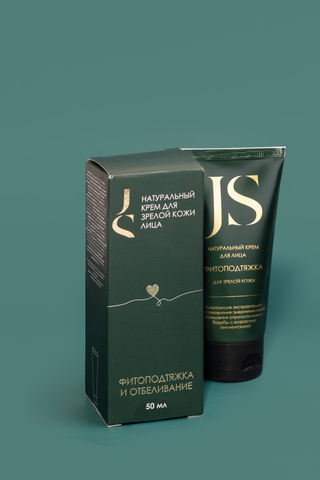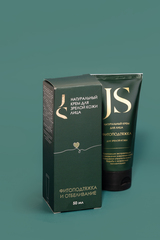JS Крем-концентрат Фитоподтяжка и отбеливание, туба 50 мл
Состав:
вода очищенная (Aqua); масло
конопли холодного отжима (Cannabis Sativa
Seed Oil); масло рисовых отрубей холодного
отжима (Oryza Sativa Germ Oil): натуральный
эмульгатор из глюкозы и раст. масел*
(Polyglyceryl-3 Methylglucose Distearate);
витамин B3 (Niacinamide); арбутин из
экстракта толокнянки (Arctostaphylos Uva Ursi
Extract); фитокератин ** (Hydrolyzed Soy and
Rice Protein); масло энотеры (Oenothera
Biennis Oil); экстракты золотого корня
(Rhodiola Rosea Extract); масло зародышей
пшеницы (Triticum Vulgare (Wheat) Germ Oil);
пребиотик** (Sorbitol); провитамин B5
(Panthenol); натур. витамин E (Tocopherols
Blend): витамин B11 (Carnitine): глицин**
(Glycine): витамин Р из цитрусовых (Rutin);
натрия PCA** (Sodium PCA); молочная кислота
(Lactic Acid); витамин С (Ascorbyl Palmitate,
Ascorbic Acid); органический консервант
Sharomix 708* (Benzyl Alcohol, Benzoic Acid,
Sorbic Acid, Glycerin); натурально-
восстановленное эфирное масло розы
(Rose Turkish Natural Essential Oil Restoring):
витамин A (Retinol).
(*) разрешены европейскими системами экосертификации для органической косметики
(**) компоненты NMF (натурального увлажняющего фактора)
Разбор состава:
https://www.youtube.com/watch?v=iwEDBfzziz8
Описание:
- Золотой корень содержит гликозид родиолозид (салидрозин), активно стимулирующий синтез кожей эластина – белка, отвечающего за эластичность кожи и красивый овал лица. Кроме этого, родиолозид значительно улучшает энергетику клеток кожи (вызывает увеличение митохондрий), приближая качество жизни клеток (метаболизма) к уровню молодой здоровой кожи.
- Толокнянка содержит натуральный арбутин в биодоступной для кожи форме, который борется с возрастной пигментацией и предотвращает появление новых пятнышек.
- Масло энотеры (вечерней примулы) содержит до 10 % гаммалиноленовой кислоты, которая необходима для формирования мембран новых клеток и прекрасно убирает возрастную сухость кожи.
- Фитокератин (комплекс гидролизованных протеинов сои и риса) имеет идеальный профиль аминокислот, как у кератина. Увеличивает плотность и увлажненность верхних слоев кожи.
- Масло рисовых отрубей, гидролизаты растительных белков и витамины смягчают и питают кожу, восстанавливая ее жизненные силы.
Способ применения: Небольшое количество крема нанести на лицо по массажным линиям, деликатн вклепать кончиками пальцев, не растягивая кожу. Применять 2 раза в день.
Внимание: возможна индивидуальная непереносимость компонентов.
Исследования
Экстракт золотого корня ,
- Calcabrini C. et al. Rhodiola rosea ability to enrich cellular antioxidant defences of cultured human keratinocytes //Archives of dermatological research. – 2010. – Т. 302. – №. 3. – С. 191-200.
DOI 10.1007/s00403-009-0985-z
- Panossian A., Wikman G., Sarris J. Rosenroot (Rhodiola rosea): traditional use, chemical composition, pharmacology and clinical efficacy //Phytomedicine. – 2010. – Т. 17. – №. 7. – С. 481-493.
https://doi.org/10.1016/j.phymed.2010.02.002
- Toh W. H. et al. The Effects of Phenolic Compounds Isolated from Chinese Herbal Medicine Rhodiola Rosea on Preventing Photoaging of Keratinocytes //bioRxiv. – 2021.
https://doi.org/10.1101/2021.04.26.441423
экстракт толокнянки ,
- Seo D. H. et al. Biotechnological production of arbutins (α-and β-arbutins), skin-lightening agents, and their derivatives //Applied microbiology and biotechnology. – 2012. – Т. 95. – №. 6. – С. 1417-1425.
DOI: 10.1007/s00253-012-4297-4
- Rendon M. I., Gaviria J. I. Review of skin‐lightening agents //Dermatologic surgery. – 2005. – Т. 31. – С. 886-890.
https://doi.org/10.1111/j.1524-4725.2005.31736
- Binic I. et al. Skin ageing: natural weapons and strategies //Evidence-Based Complementary and Alternative Medicine. – 2013. – Т. 2013.
http://dx.doi.org/10.1155/2013/827248
- Migas P., Krauze-Baranowska M. The significance of arbutin and its derivatives in therapy and cosmetics //Phytochemistry Letters. – 2015. – Т. 13. – С. 35-40.
https://doi.org/10.1016/j.phytol.2015.05.015
масло энотеры ,
- Chang M. Y. et al. Effects of the mixture of vitamin C, vitamin E, pycnogenol and evening primrose oil on the UV-induced pigmentation and wrinkle reductions in human skin //Korean Journal of Nutrition. – 2009. – Т. 42. – №. 6. – С. 516-522.
DOI: 10.4163/kjn.2009.42.6.516
- Koo J. H. et al. Saponified Evening Primrose Oil Reduces Melanogenesis in B16 Melanoma Cells and Reduces UV‐Induced Skin Pigmentation in Humans //Lipids. – 2010. – Т. 45. – №. 5. – С. 401-407.
DOI 10.1007/s11745-010-3405-4
- Muggli R. Systemic evening primrose oil improves the biophysical skin parameters of healthy adults //International journal of cosmetic science. – 2005. – Т. 27. – №. 4. – С. 243-249.
https://doi.org/10.1111/j.1467-2494.2005.00274.x
фитокератин ,
- Chen H. J. et al. Evaluating the Antioxidants, Whitening and Antiaging Properties of Rice Protein Hydrolysates //Molecules. – 2021. – Т. 26. – №. 12. – С. 3605.
https://doi.org/10.3390/molecules26123605
- Wattanasiritham L. et al. Isolation and identification of antioxidant peptides from enzymatically hydrolyzed rice bran protein //Food Chemistry. – 2016. – Т. 192. – С. 156-162.
https://doi.org/10.1016/j.foodchem.2015.06.057
- Zhang R. et al. Protection effects of rice protein hydrolysate on UVB-irradiated photodamage in Hartley guinea pigs skin and human skin fibroblasts //Journal of Functional Foods. – 2021. – Т. 82. – С. 104504.
https://doi.org/10.1016/j.jff.2021.104504
витамин В3 (ниацинамид)
- Cosmetic Ingredient Review Expert Panel et al. Final report of the safety assessment of niacinamide and niacin //International journal of toxicology. – 2005. – Т. 24. – С. 1-31.
DOI: 10.1080 / 10915810500434183
- Wohlrab J., Kreft D. Niacinamide-mechanisms of action and its topical use in dermatology //Skin pharmacology and physiology. – 2014. – Т. 27. – №. 6. – С. 311-315.
https://doi.org/10.1159/000359974
витамин Е
- Ramos-e-Silva M. et al. Anti-aging cosmetics: Facts and controversies //Clinics in dermatology. – 2013. – Т. 31. – №. 6. – С. 750-758.
https://doi.org/10.1016/j.clindermatol.2013.05.013
- Packer L., Valacchi G. Antioxidants and the response of skin to oxidative stress: vitamin E as a key indicator //Skin Pharmacology and Physiology. – 2002. – Т. 15. – №. 5. – С. 282-290.
https://doi.org/10.1159/000064531
- Nachbar F., Korting H. C. The role of vitamin E in normal and damaged skin //Journal of Molecular Medicine. – 1995. – Т. 73. – №. 1. – С. 7-17.
https://doi.org/10.1007/BF00203614
- Thiele J. J., Ekanayake-Mudiyanselage S. Vitamin E in human skin: organ-specific physiology and considerations for its use in dermatology //Molecular aspects of medicine. – 2007. – Т. 28. – №. 5-6. – С. 646-667.
doi:10.1016/j.mam.2007.06.001
витамин А
- Yoshioka A. et al. Anti-oxidant effects of retinoids on inflammatory skin diseases //Archives of dermatological research. – 1986. – Т. 278. – №. 3. – С. 177-183.
https://doi.org/10.1007/BF00412920
- Zasada M., Budzisz E. Retinoids: Active molecules influencing skin structure formation in cosmetic and dermatological treatments //Advances in Dermatology and Allergology/Postȩpy Dermatologii i Alergologii. – 2019. – Т. 36. – №. 4. – С. 392.
DOI: https://doi.org/10.5114/ada.2019.87443
- Słoczyńska K. et al. Skin metabolism established with the use of MetaSite for selected retinoids employed in topical and systemic treatment of various skin disorders and found in cosmeceuticals //Acta Biochimica Polonica. – 2015. – Т. 62. – №. 2.
http://dx.doi.org/10.18388/abp.2014_891
Перед публикацией отзывы проходят модерацию






